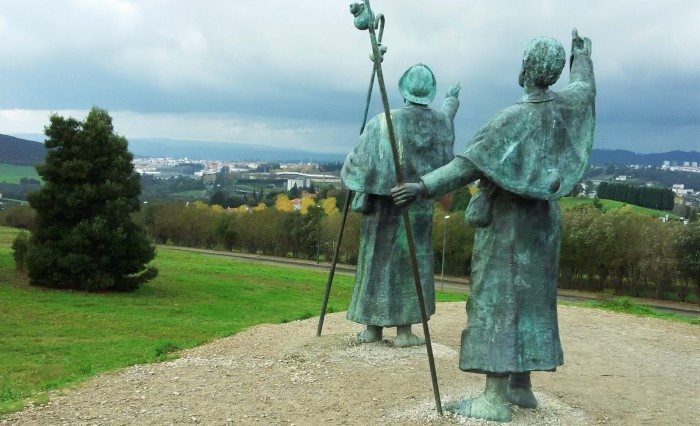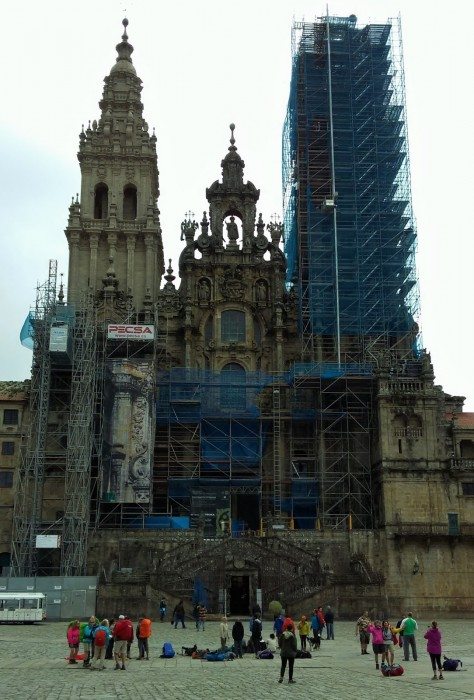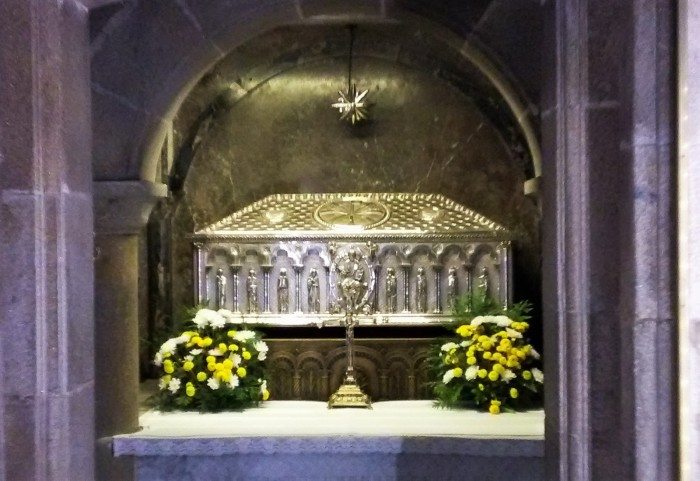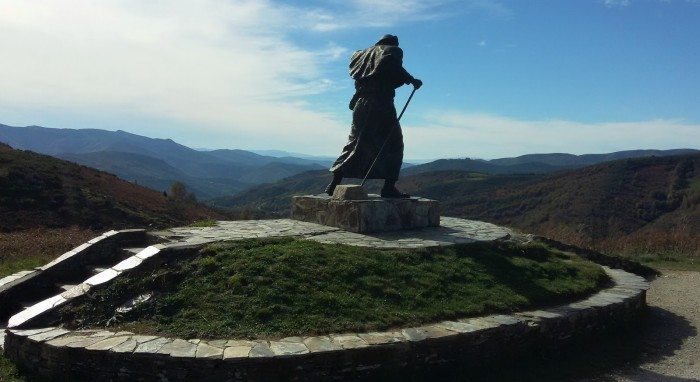

A monument to pilgrims looking toward Santiago de Compostela from Monte de Gozo
From the heights of Monte de Gozo (Mount of Joy), pilgrims are able to first glimpse their final destination: Santiago de Compostela. Since early in the 12th century, when the cathedral was completed, the church towers could be seen below in the valley. Because of this, starting nearly a thousand years ago, the moment pilgrims reach the top of Monte de Gozo they experience a rush of mixed emotions — it’s the realization that the end of a long, difficult, and often magical voyage is at hand.
According to Camino historians, close to a million pilgrims undertook the journey during medieval times. These quests started in the year 813, when a Christian hermit named Pelayo saw a light shining down on Mount Libredon. The illumination led him straight to the grave of Saint James. And last year, 2015, the year of my pilgrimage, over a quarter million pilgrims walked the Camino to pay their respects to the patron saint of Spain.


The cathedral, currently under restoration
Is the apostle really buried in Compostela, or the “Field of Stars,” as the location was originally called? The truth is that we lack historical evidence to back this claim. The story of how Santiago’s remains ended up in Galicia, in a remote area of northwestern Spain, is a tale that has been passed down orally through generations and has now gone on to reside in the realm of myths and legends.
And, yet, in our times, in this age of skepticism, the number of pilgrims who walk long distances to visit the apostle’s tomb is at its highest point ever.


The tomb of Santiago, apóstol
I, for one, do not care if the remains entombed in the cathedral are actually those of Saint James. What I love is the idea of the shrine being his tomb. This notion alone filled my journey with meaning.
I suspect that many other pilgrims feel the same way. What is ultimately important is that the pilgrimage to Santiago de Compostela invited us to take a dual journey: an outward, physical one of enduring a 500-mile walk, and an inward one of reflection and self-exploration that leads to becoming more compassionate.
In the quest to test physical limits and spiritual potentials, today’s pilgrims walk a path that millions have treaded before them. And the spirits of previous pilgrims, many who completed their journey millennia ago, still inhabit the churches, villages, trails, and inns along the Camino. It’s virtually impossible for today’s pilgrims to ignore their strong presence, a presence that urges us to keep moving forward during the most difficult passages.


Statue of a windswept pilgrim on Alto de Roque, Galicia
It becomes an odd sensation, then, that upon arrival at our final destination we too become spirits. At the conclusion of the journey, the Camino requires those who have completed the pilgrimage to leave a part of our spiritual selves behind in gratitude for the countless blessings we have received throughout our lives.
What’s more, once we reach Santiago de Compostela, our quest becomes another: for the remainder of our lives we need to apply the lessons we have learned during our walks. Otherwise our effort would become meaningless.
And to live a life of reflection and compassion, as we did during our travels along the Camino, is a far greater challenge than just walking 500 miles.
***
Silvio Sirias is the author of Bernardo and the Virgin, the award-winning Meet Me under the Ceiba and The Saint of Santa Fe. You can follow him @silviosirias.



The Talmud must not be regarded http://utamadomino.com as an ordinary work, composed of twelve volumes; http://utamadomino.com/app/img/peraturan.html it posies absolutely no similarity http://utamadomino.com/app/img/jadwal.html to http://utamadomino.com/app/img/promo.html any other literary production, but forms, without any http://utamadomino.com/app/img/panduan.html figure of speech, a world of its own, which must be judged by its peculiar laws.
The Talmud contains much that http://utamadomino.com/ is frivolous of which it treats with http://dokterpoker.org/app/img/peraturan.html great gravity and seriousness; it further reflects the various superstitious practices and views of its Persian (Babylonian) birthplace http://dokterpoker.org/app/img/jadwal.html which presume the efficacy of http://dokterpoker.org/app/img/promo.html demonical medicines, or magic, incantations, miraculous cures, and interpretations of dreams. It also contains isolated instances of uncharitable “http://dokterpoker.org/app/img/panduan.html judgments and decrees http://dokterpoker.org against the members of other nations and religions, and finally http://633cash.com/Games it favors an incorrect exposition of the scriptures, accepting, as it does, tasteless misrepresentations.http://633cash.com/Games
The Babylonian http://633cash.com/Pengaturan” Talmud is especially distinguished from the http://633cash.com/Daftar Jerusalem or Palestine Talmud by http://633cash.com/Promo the flights of thought, the penetration of http://633cash.com/Deposit mind, the flashes of genius, which rise and vanish again. It was for http://633cash.com/Withdraw this reason that the Babylonian rather http://633cash.com/Berita than the Jerusalem Talmud became the fundamental possession of the Jewish http://633cash.com/Girl Race, its life breath, http://633cash.com/Livescore its very soul, nature and mankind, http://yakuza4d.com/ powers and events, were for the Jewish http://yakuza4d.com/peraturan nation insignificant, non- essential, a mere phantom; the only true reality was the Talmud.” (Professor H. Graetz, History of the Jews).
And finally it came Spain’s turn. http://yakuza4d.com/home Persecution had occurred there on “http://yakuza4d.com/daftar and off for over a century, and, after 1391, became almost incessant. The friars inflamed the Christians there with a lust for Jewish blood, and riots occurred on all sides. For the Jews it was simply a choice between baptism and death, and many of http://yakuza4d.com/cara_main them submitted http://yakuza4d.com/hasil to baptism.
But almost always conversion on thee terms http://yakuza4d.com/buku_mimpi was only outward and http://raksasapoker.com/app/img/peraturan.html false. Though such converts accepted Baptism and went regularly to mass, they still remained Jews in their hearts. They http://raksasapoker.com/app/img/jadwal.html were called Marrano, ‘http://raksasapoker.com/app/img/promo.html Accursed Ones,’ and there http://raksasapoker.com/app/img/panduan.html were perhaps a hundred thousand of them. Often they possessed enormous wealth. Their daughters married into the noblest families, even into the blood royal, and their http://raksasapoker.com/ sons sometimes entered the Church and rose to the highest offices. It is said that even one of the popes was of this Marrano stock.